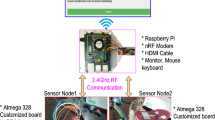Abstract
Stroke is one of the high-risk diseases with a global concern that has caused the death of millions of individuals and is still ravaging lives of people in many countries–like fire in a wild forest. Stroke occurrences are highly influenced by age and other factors such as blood pressure, heart pulses, and feeding habits. Hemorrhagic stroke is prevalent among the age groups of 16 and 50 years-stimulated by chronic high blood pressure, heartbeat problems, and aging blood vessels. These health factors can be collected from patients and processed to monitor their health conditions in real-time-such as to reduce the number of death cases caused by stroke. In this research, an IoT-based healthcare delivery system for hemorrhagic stroke patients was developed using a wearable device and a fog computing approach for monitoring vital symptoms of the patients and administering on-demand health care services to the users. The IoT device is capable of detecting irregular blood pressure and heartbeat using a Continuous Wavelength Transform (CWT) signal and performing analytics on the data collected using a rule-based mining algorithm on the wearable firmware enhanced with a robust database model and a fog layer for efficient data analytics. The system was implemented in the form of a wearable armband for the user and supported with a dynamic web page for device allocation and real-time monitoring of the patient’s health status. The wearable device was able to communicate to the user in real-time-notifying them of their health status, recommending preventive actions to be taken, and alerting their doctors when there are emergencies- using the fog computing layer to reduce data latency and provide fast response time. In evaluating the performance of our system, the readings from the wearable armband for monitoring the blood pressure and heartbeat were compared with the patient’s reading using the standard Sphygmomanometer and Pulse oximeter, the results show high accuracy relative to the outputs of our wearable IoT device.
Access this chapter
Tax calculation will be finalised at checkout
Purchases are for personal use only
Similar content being viewed by others
References
Andreu-Perez, J., Leff, D.R., Ip, H., Yang, G.-Z.: From wearable sensors to smart implants - towards pervasive and personalised healthcare (2014)
Balogun, V., Sarumi, O.A., Balogun, O.D.: A non-invasive cloud-based IoT system and data analytics support for women struggling with drug addictions during pregnancy. In: Goleva, R., Garcia, N.R.C., Pires, I.M. (eds.) HealthyIoT 2020. LNICST, vol. 360, pp. 20–34. Springer, Cham (2021). https://doi.org/10.1007/978-3-030-69963-5_2
AlMotiri, S.H., Khan, M.A., AlGhamdi, M.A.: Mobile health (m-health) system in the context of IoT. In: 4th International Conference on Future Internet of Things and Cloud Workshops, pp. 39–42 (2016)
Joel, J.P.C., et al.: Enabling technologies for the internet of health things 20, 1–9 (2018)
Chen, R.L., Balami, J., Esiri, M., Chen, L.K., Buchan, A.: Ischemic stroke in the elderly: an overview of evidence. Nat. Rev. Neurol. 6(1), 256–265 (2010)
Halday: Hemorrhagic stroke, vol. 2, pp. 1–43 (2017)
Leung, C.K., Sarumi, O.A., Zhang, C.Y.: Predictive analytics on genomic data with high- performance computing. IEEE BIBM 2020, 2187–2194 (2020). https://doi.org/10.1109/BIBM49941.2020.9312982
Sarumi, O.A., Leung, C.K.: Adaptive machine learning algorithm and analytics of big genomic data for gene prediction. In: Mehta, M., Fournier-Viger, P., Patel, M., Lin, J.C.-W. (eds.) Tracking and Preventing Diseases with Artificial Intelligence. ISRL, vol. 206, pp. 103–123. Springer, Cham (2022). https://doi.org/10.1007/978-3-030-76732-7_5
Sarumi, O.A., Aouedi, O., Muhammad, L.J.: Potential of deep learning algorithms in mitigating the spread of COVID-19. In: Nayak, J., Naik, B., Abraham, A. (eds.) Understanding COVID-19: The Role of Computational Intelligence. SCI, vol. 963, pp. 225–244. Springer, Cham (2022). https://doi.org/10.1007/978-3-030-74761-9_10
Sarumi, O.A.: Machine learning-based big data analytics framework for ebola outbreak Surveillance. In: Abraham, A., Piuri, V., Gandhi, N., Siarry, P., Kaklauskas, A., Madureira, A. (eds.) ISDA 2020. AISC, vol. 1351, pp. 580–589. Springer, Cham (2021). https://doi.org/10.1007/978-3-030-71187-0_53
Jongbo, O.A., Adetunmbi, A.O., Ogunrinde, R.B., Badeji-Ajisafe, B.: Development of an ensemble approach to chronic kidney disease diagnosis. Sci. African 8, e00456 (2020)
Oguntimilehin, A., Adetunmbi, A.O., Abiola, O.B.: A machine learning approach to clinical diagnosis of typhoid fever. Mach. Learn. Approach Clin. Diagn. Typhoid Fever 2(4), 1–6 (2013)
Carla, B., Ritse, M., Mann, D., Hylek, G., Hylek, E.: Stroke prevention in elderly patients with atrial fibrillation 370, 493 (2007)
Dohr, R., Modre-Osprian, M., Drobics, D., Hayn, G.: The internet of things for ambient assisted living (2010)
Wahidah, H., Siti, A.M.Z., Nur, A.R., Amirah, M.Z.: integrating IoT devices into a mobile application for elderly who live alone ARPN. J. Eng. Appl. Sci. 10 (23)
Almotiri, S.H., Khan, M.A., Alghamdi, M.A.: Mobile health system in the context of IoT. In: 4th International Conference on Future Internet of Things and Cloud Workshops, vol. 4 , no. 24 (2016)
Akm, J.A., Majumder, Y.E., Mohammed, E., Donald, R.U., Farzana, R.: A wireless IoT system towards gait detection in stroke patients. In: IEEE First International Workshop on Mobile & Pervasive Internet of Things, 978-1-5090-4338-5/17 (2017)
Ani, R., Krishna, S.: IOT based patient monitoring system for stroke affected patients. J. Adv. Res. Dyn. Control Syst. 10(6), 1162–1167 (2018)
Author information
Authors and Affiliations
Corresponding author
Editor information
Editors and Affiliations
Rights and permissions
Copyright information
© 2022 The Author(s), under exclusive license to Springer Nature Switzerland AG
About this paper
Cite this paper
Abosede, S.A., Adetunmbi, A.O., Sarumi, O.A. (2022). On-demand Data Analytics Support for Hemorrhagic Stroke Patients Using Wearable IoT Device and Fog Computing Technology. In: Abraham, A., et al. Proceedings of the 13th International Conference on Soft Computing and Pattern Recognition (SoCPaR 2021). SoCPaR 2021. Lecture Notes in Networks and Systems, vol 417. Springer, Cham. https://doi.org/10.1007/978-3-030-96302-6_37
Download citation
DOI: https://doi.org/10.1007/978-3-030-96302-6_37
Published:
Publisher Name: Springer, Cham
Print ISBN: 978-3-030-96301-9
Online ISBN: 978-3-030-96302-6
eBook Packages: Intelligent Technologies and RoboticsIntelligent Technologies and Robotics (R0)




